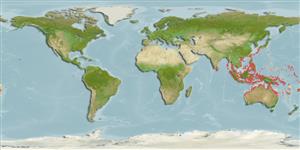Common names from other countries
Environment: milieu / climate zone / depth range / distribution range
Οικολογία
Υφαλόφιλο(α); εύρος βάθους 0 - 6 m (Ref. 99823). Tropical
Indo-West Pacific.
Length at first maturity / Μέγεθος / Βάρος / Age
Maturity: Lm ? range ? - ? cm Max length : 12.0 cm CW αρσενικό/απροσδιόριστο; (Ref. 343)
Surface of carapace smooth, sometimes with low pubescence; ridges distinct; front with 6 lobes, median 4 lobes truncate, lateral 2 lobes rounded. Color: usually bright red overall, but sometimes green, or with a mixture of red and green. Easily distinguished by its spinose palm and the bright red coloration.
Also caught by nets. Intertidal to subtidal (Ref. 106854).
Life cycle and mating behavior
Γεννητική Ωρίμανση | Αναπαραγωγή | Γεννοβολία | Αβγά | Γονιμότητα | Προνύμφες
Members of the order Decapoda are mostly gonochoric. Mating behavior: Precopulatory courtship ritual is common (through olfactory and tactile cues); usually indirect sperm transfer.
Ng, P.K.L. 1998. (Ref. 343)
IUCN Red List Status (Ref. 130435)
CITES status (Ref. 108899)
Not Evaluated
Not Evaluated
Human uses
αλιεία: Εμπορικό(ά)
| FishSource |
Εργαλεία
Διαδικτυακές πηγές
Estimates based on models
Preferred temperature
(Ref.
115969): 24.9 - 29.3, mean 28.6 (based on 2437 cells).
Vulnerability
Low vulnerability (10 of 100).
Price category
Unknown.
